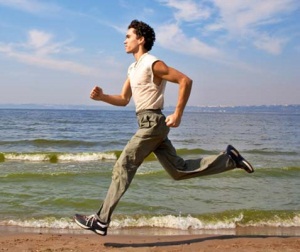 Exercising 15 minutes a day provides health benefits, a study finds, good news to those who are always strapped for time. The study, which appeared in the journal the Lancet this week, found that doing 15 minutes of leisure time physical activity was linked with an average three added years of life expectancy, along with a 10% decrease in cancer mortality and a 20% drop in cardiovascular disease, compared with sedentary people.
Exercising 15 minutes a day provides health benefits, a study finds, good news to those who are always strapped for time. The study, which appeared in the journal the Lancet this week, found that doing 15 minutes of leisure time physical activity was linked with an average three added years of life expectancy, along with a 10% decrease in cancer mortality and a 20% drop in cardiovascular disease, compared with sedentary people.
So now that we have the good news, just what can you do in 15 minutes? A lot, says Mike Donavanik, a Beverly Hills-based personal trainer and certified strength and conditioning specialist.
Let’s start with cardio. Getting the heart rate up is easy with a fast-paced walk or moderate jog. Depending on how fast you walk or run, Donavanik says, you could cover 1.5 to 2 miles in a quarter of an hour. Already fit? Try walking up stairs. But start to slack off and you won’t get the health benefits of an elevated heart rate, so be sure your heart rate is in the target zone–he recommends exercising at 60% to 75% of your maximum heart rate.
How to get that number? Some private training facilities provide tests (for a fee) to get a precise figure, and easy formulas exist that can give a very broad ballpark (maximum heart rate = 220 – your age). A heart rate monitor makes numbers easily accessible while exercising. Or simplify things by using the talk test, formally called the rate of perceived exertion–monitoring your body to see how hard you’re working.
“If you’re walking you want to be somewhat out of breath,” Donavanik says. “You shouldn’t be able to hold a regular conversation if you’re walking with a friend or on the cellphone.”
Alternate cardio workouts with resistance training. No gym is needed–a 15-minute circuit using only body resistance can work several major muscle groups. Donavanik recommends a course of five of the following exercises: push-ups and squats (alternating with lunges) for the lower body, triceps dips and shoulder presses for the upper body, and crunches for core work.
Spend one minute on each exercise and cycle through three times for 15 minutes. If you’re just off the couch this is still doable, Donavanik says, but modify the routine to suit your abilities. Instead of doing regular plank push-ups on the toes, for example, do them on your knees, but still maintain good form. A few two- or three-minute breaks are allowed, but don’t count them toward your 15 minutes, since that would be cheating, wouldn’t it?
Add some light dumbbells or resistance bands and your workout accelerates, Donavanik says. “With just one band you can do bicep curls, shoulder presses, shoulder raises, you can add difficulty to squats–it’s literally a portable gym. There’s no reason you should get bored with one band.”
In a pinch, he adds, gallon-size plastic jugs with handles can be filled with water for quick eight-pound weights. Fill them with sand instead and the weight goes to about 12 pounds.
Do these exercises consistently and you should see improvement. Donavanik suggests logging your workouts to keep a record of your progress. “Let’s say the first week you were only able to do 10 modified push-ups. Next week, try going for 12, and the week after that, 15.”
Anyone can get in some exercise on a lunch break, he adds. “There’s no excuse not to be able to do 15 minutes.”
–
Source: LA Times

